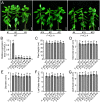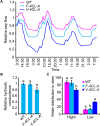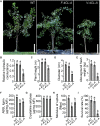Cell-Specific Suppression of 4-Coumarate-CoA Ligase Gene Reveals Differential Effect of Lignin on Cell Physiological Function in Populus
- PMID: 33281849
- PMCID: PMC7705072
- DOI: 10.3389/fpls.2020.589729
Cell-Specific Suppression of 4-Coumarate-CoA Ligase Gene Reveals Differential Effect of Lignin on Cell Physiological Function in Populus
Abstract
Lignin is a main component of the secondary cell wall in vessels and fibers of xylem tissue. However, the significance of lignin in cell physiology during plant growth is unclear. In this study, we generated lignin-modified Populus via cell-specific downregulation of the 4-coumarate-CoA ligase gene (4CL). The transgenic plants with selective lignin modification in vessel elements or fiber cells allowed us to investigate how lignin affects the physiology of vessel or fiber cells in relation to plant growth. Results showed that vessel-specific suppression of lignin biosynthesis resulted in deformed vessels and normal fibers, while fiber-specific suppression of lignin biosynthesis led to less-lignified fibers and normal vessels. Further analyses revealed that the efficiency of long distance water transport was severely affected in transgenics with vessel-specific lignin modification, while minimal effect was detected in transgenics with fiber-specific lignin modification. Vessel-specific lignin reduction led to high susceptibility to drought stress and poor growth in field, likely due to vessel defects in long distance transport of water. The distinct physiological significance of lignin in different cell types provides insights into the selective modification of lignin for improvement of lignocellulosic biomass utilization.
Keywords: 4-coumarate-CoA ligase gene; Populus; fiber cell; lignin; vessel; xylem.
Copyright © 2020 Cao, Huang, Luo, Zheng, Zhong, Sun, Gui and Li.
Figures






References
-
- De Meester B., de Vries L., Ozparpucu M., Gierlinger N., Corneillie S., Pallidis A., et al. (2018). Vessel-specific reintroduction of CINNAMOYL-COA REDUCTASE1 (CCR1) in dwarfed ccr1 mutants restores vessel and Xylary fiber integrity and increases biomass. Plant Physiol. 176 611–633. 10.1104/pp.17.01462 - DOI - PMC - PubMed
LinkOut - more resources
Full Text Sources

